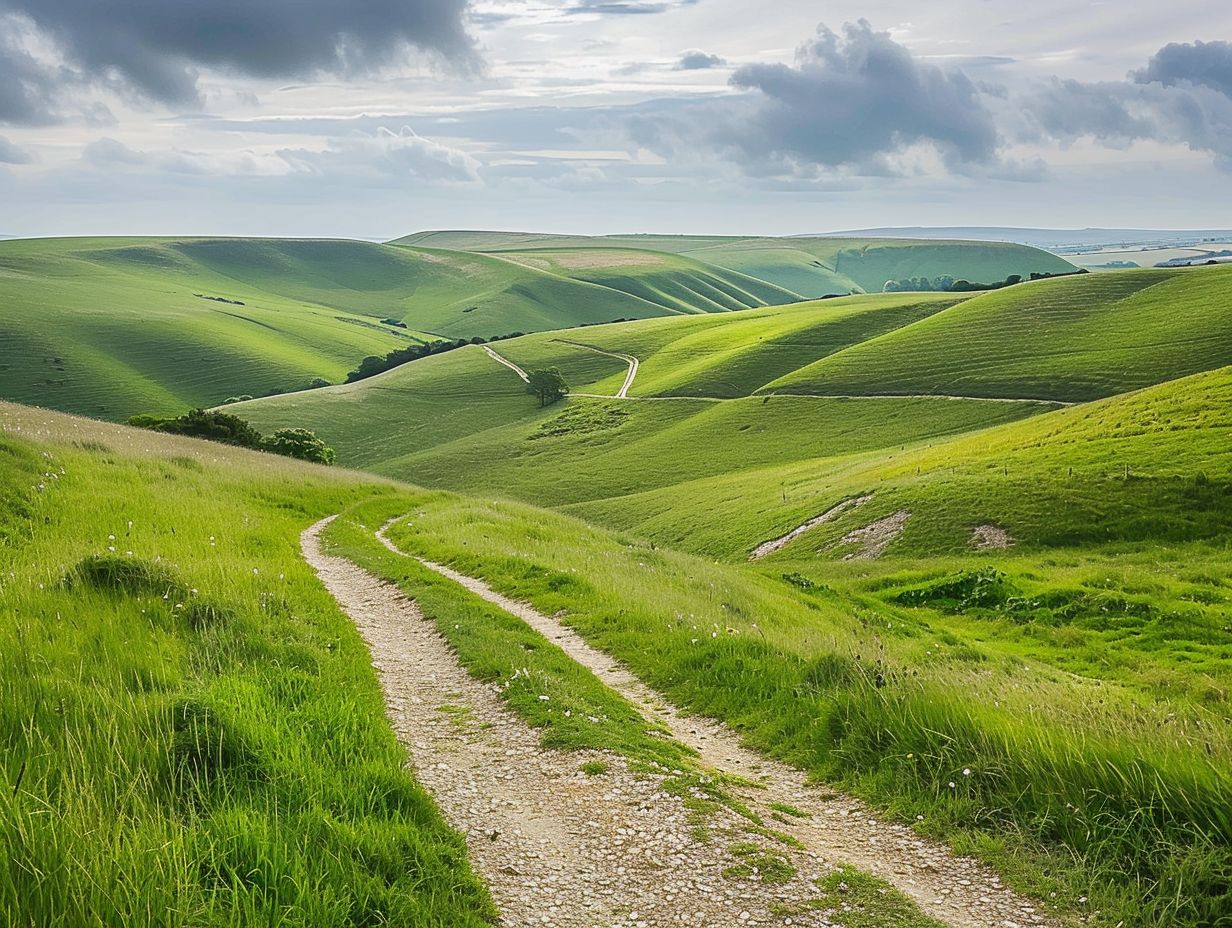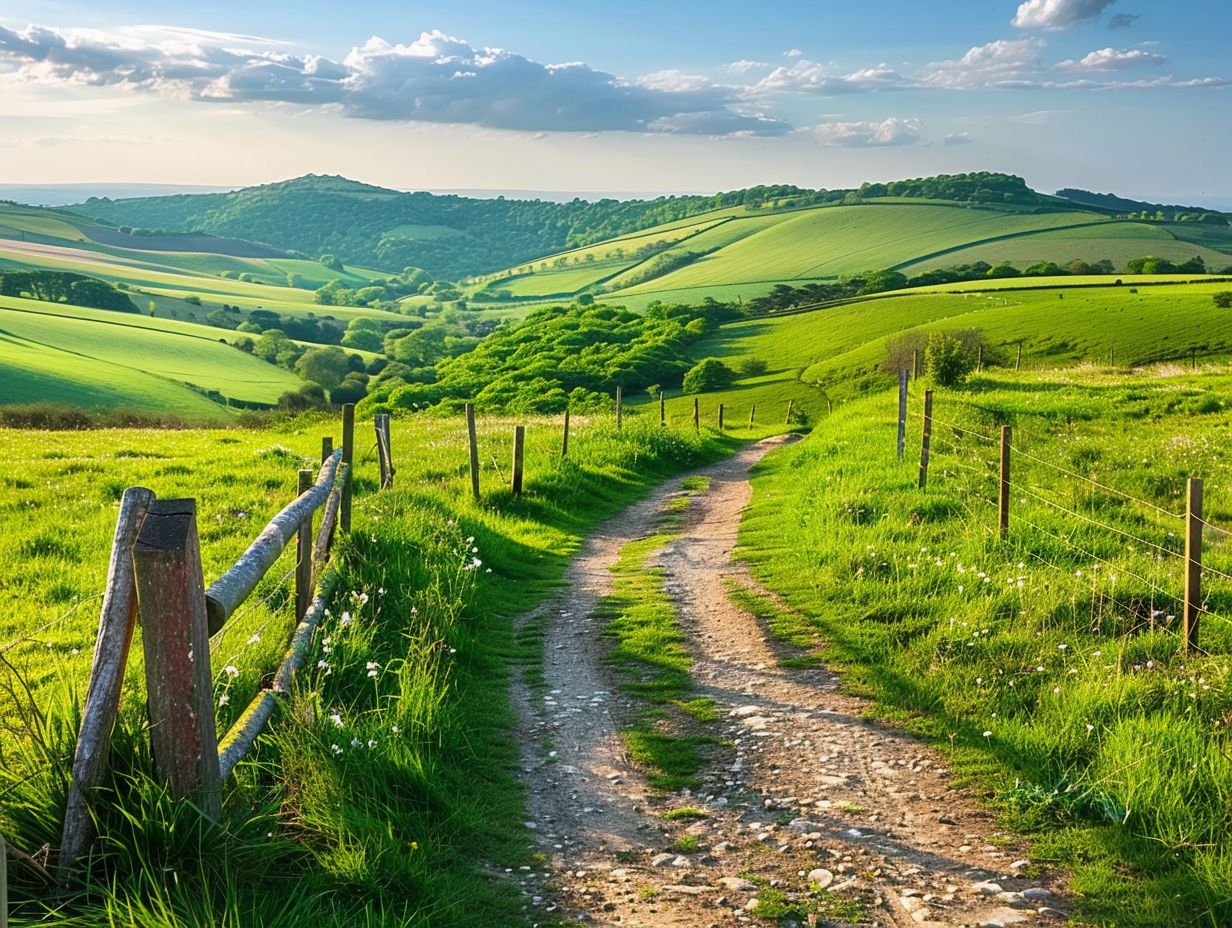Have you ever dreamed of exploring rolling hills, picturesque villages, and stunning coastline? Look no further than the South Downs Way.
This iconic trail in southern England offers a unique hiking experience that attracts outdoor enthusiasts from around the world.
From the charming town of Winchester to the vibrant coastal town of Eastbourne, the South Downs Way showcases the natural beauty and rich history of the region.
Join us as we dive into the main attractions, best times to hike, and essential gear for your adventure along this breathtaking trail.
Key Takeaways:

- Experience the picturesque landscapes and serene atmosphere of the South Downs Way, a popular hiking destination in southern England.
- This long-distance trail offers a variety of attractions, from historic sites to stunning views, making it a must-visit for nature lovers and history enthusiasts alike.
- Plan your hike carefully, considering factors like the weather and the different sections of the trail, and make sure to pack essential gear and supplies for a safe and enjoyable journey.
What Is the South Downs Way?
The South Downs Way is a well-known long-distance trail that spans 100 miles (160 km) across the picturesque landscapes of Southern England. This trail is located within a designated National Park and offers hikers a diverse path that encompasses historic landmarks, quaint villages, and stunning views of the countryside.
Noteworthy for its historical significance, the South Downs Way features sections that date back to ancient times, with bronze age barrows and Iron Age hill forts scattered throughout the landscape. The trail passes through a range of habitats, including chalk grasslands, woodlands, and heathlands, creating a varied ecosystem for wildlife.
Serving a pivotal role in the National Park system, the trail links different conservation areas and supports the conservation of diverse flora and fauna along its course.
Where Is the South Downs Way Located?
The South Downs Way is situated in southern England, commencing in the historically significant city of Winchester and concluding in the coastal town of Eastbourne.
Spanning a distance of approximately 100 miles, this trail showcases breathtaking views of verdant valleys, undulating hills, and picturesque villages along its course.
Noteworthy towns encountered on this route include Amberley, where visitors can explore the 900-year-old castle, and Alfriston, renowned for its charming tea houses and historic edifices.
As individuals traverse from the inland city of Winchester towards the coastal destination of Eastbourne, they will experience a striking transformation in landscapes, transitioning from the gentle slopes of the Downs to the magnificent cliffs that overlook the English Channel.
The trail is clearly demarcated with unique acorn symbols, ensuring that travellers maintain their course throughout the entirety of their journey.
Why Is the South Downs Way a Popular Destination?
The South Downs Way is a renowned destination that draws a multitude of walkers and outdoor enthusiasts. Its allure lies in the breathtaking countryside, rich historical significance, diverse wildlife, and impeccably preserved landscapes, collectively offering a quintessential English walking experience.
What Are the Main Attractions Along the South Downs Way?
Hikers traversing the South Downs Way can anticipate an enriching experience exploring prominent attractions along the route. These attractions include the historic Winchester Cathedral, the ancient Old Winchester Hill Iron Age Fort, the mystical Chanctonbury Ring, and the awe-inspiring landscapes of the Seven Sisters and Beachy Head.
Winchester Cathedral, with its exquisite English Gothic architecture, boasts a rich history dating back to the 11th century. Renowned for its magnificent medieval stained glass windows, intricate ceilings, and compelling historical significance, the cathedral stands as a testament to architectural and artistic excellence.
The Old Winchester Hill Iron Age Fort presents hikers with a unique window into ancient civilizations through its remarkable earthworks and sweeping vistas of the surrounding landscape. Offering a glimpse into a bygone era, the fort serves as a compelling site for history enthusiasts and nature lovers alike.
Chanctonbury Ring, characterised as a prehistoric hill fort, is steeped in folklore and enigma, rendering it a captivating destination for individuals intrigued by ancient myths and legends. The site’s mysterious aura and historical significance make it a compelling stop along the South Downs Way.
As hikers venture along the trail, they will encounter the Seven Sisters cliffs, a series of striking chalk formations that soar dramatically above the sea. Known for their breathtaking coastal views and challenging hiking opportunities, the Seven Sisters cliffs offer a truly exhilarating and visually stunning experience for those exploring the South Downs Way.
How Long Does It Take to Hike the South Downs Way?
The completion of the South Downs Way typically spans a duration of 7 to 10 days for hikers, contingent upon individual physical fitness, comfort preferences, and meticulous itinerary planning.
The daily distance covered during hiking significantly influences the overall duration of the journey. Some hikers may opt for lengthier distances each day, as opposed to others who choose a more leisurely pace by breaking down the trail into smaller segments.
Introducing rest days into the schedule becomes pivotal, providing hikers with the opportunity to recover and re-energise themselves for upcoming challenges.
The diversified terrains and elevation fluctuations encountered throughout the route can pose physical and mental obstacles for hikers, affecting their speed and stamina. Therefore, it is imperative to strike a harmonious balance between pushing personal boundaries and ensuring a secure and gratifying experience along the South Downs Way.
What Are the Different Sections of the South Downs Way?
The South Downs Way is divided into various manageable sections, each presenting distinct landscapes and experiences. This division allows walkers to navigate the trail from Winchester to Eastbourne easily, supported by thorough waymarking and maps.
1. Winchester to Exton

The initial segment of the hiking trail from Winchester to Exton guides individuals through the picturesque English countryside, where they encounter significant landmarks such as the renowned Winchester Cathedral. During the course of the trail, hikers are presented with breathtaking vistas of undulating hills adorned with idyllic villages and verdant foliage.
Progressing further along the path reveals various historical sites, including the age-old Roman walls of Winchester and the ruins of medieval castles that serve as mute witnesses to centuries of historical events. The serene meadows and babbling streams provide a tranquil setting for the hike, allowing for moments of tranquillity amidst the rugged grandeur of the natural scenery.
2. Exton to Cocking
The route from Exton to Cocking provides hikers with the opportunity to encounter various wildlife and flora, offering tranquil walks amidst undulating hills and scenic villages. The area is recognised for its abundant bird species, where vibrant robins and melodious blackbirds contribute to a harmonious blend of natural melodies.
Whilst walking along the serene pathways, observers may have the chance to witness agile squirrels darting amongst the trees or elegant deer gracefully traversing the meadows. The rustic allure of the region is accentuated by charming farmhouses secluded within the rural landscape, further enhancing the overall picturesque ambiance.
3. Cocking to Amberley
Hikers traversing from Cocking to Amberley will explore historical landscapes and picturesque countryside, steeped in rich English history. The route provides a glimpse into a bygone era, characterised by ancient stone walls bordering the pathways and quaint villages scattered along the route.
Walkers are welcomed by rolling hills and verdant greenery as they make their way through the countryside, creating a scenic backdrop for their journey.
Each step along this trail represents a journey back in time, where tales of the past intertwine with the beauty of the present landscape, offering an immersive experience for individuals seeking a harmonious blend of history and natural beauty.
4. Amberley to Washington
The section from Amberley to Washington offers hikers a mix of diverse terrain and significant landmarks, presenting both challenges and rewards.
The trail winds its way through luxuriant forests populated with majestic ancient trees, providing shade and a serene atmosphere for tired travellers. As hikers navigate the rugged landscape, they will come across impressive rock formations, flowing waterfalls, and vast valleys that showcase the unadulterated beauty of nature.
Noteworthy points of interest along the route include the historic stone bridge at Milltown and the scenic overlook at Eagle’s Nest, which provides sweeping views of the surrounding countryside. Despite the attractions of these landmarks, hikers must also tackle steep inclines and rocky paths that demand endurance and agility.
5. Washington to Pyecombe
The journey from Washington to Pyecombe is characterized by undulating terrain and clear waymarkers, which ensure hikers remain on the designated path while appreciating the picturesque views.
While traversing this scenic route, individuals will be enchanted by the verdant vegetation that blankets the hillsides, providing a tranquil backdrop for their expedition. The clearly defined trail, along with its prominent waymarkers, effortlessly guides hikers through the rolling landscape, facilitating easy navigation.
Throughout the journey, hikers will come across quaint villages nestled amidst the hills, which offer charming pubs and cosy cafes where they can pause for a well-deserved respite. This segment of the route is not solely focused on reaching the destination but also on savouring each step and admiring the natural beauty that envelops the surroundings.
6. Pyecombe to Southease
The picturesque journey from Pyecombe to Southease offers hikers an immersive experience in a landscape abundant with diverse flora and fauna, showcasing the natural beauty of the South Downs.
As hikers traverse this captivating stretch, they are greeted by a plethora of wildflowers embellishing the rolling hillsides, which introduce vibrant splashes of colour to the already scenic surroundings. The melodic calls of various bird species resonate through the air, enriching the tranquil ambiance.
Alongside the varied plant life, the South Downs also harbours a diverse range of wildlife, including deer, rabbits, and occasional foxes darting through the undergrowth. The multifaceted ecosystems present in this area offer a glimpse into the intricate interconnections of life flourishing within these expansive landscapes.
7. Southease to Eastbourne
The segment from Southease to Eastbourne offers hikers a picturesque route along the dramatic coastal cliffs of the Seven Sisters and Beachy Head, providing stunning sea views and a memorable conclusion to the trail.
The imposing white chalk cliffs of the Seven Sisters present a striking contrast against the deep blue waters below, capturing the attention of all who travel this path. Along the way to Eastbourne, hikers will encounter the iconic Beachy Head Lighthouse, a symbol of maritime heritage positioned at the edge of the steep cliff.
The sense of accomplishment upon reaching the conclusion of the trail at Eastbourne pier, surrounded by the sounds of crashing waves and seabirds, is truly unmatched.
What Are the Best Times to Hike the South Downs Way?

The optimal periods for embarking on a hike along the South Downs Way are the spring and autumn seasons. During these times, the weather tends to be moderate, and the natural landscape displays its most vivid colours, rendering it well-suited for both self-guided hikes and organised guided hiking excursions.
What Is the Weather Like Along the South Downs Way?
The climate conditions experienced along the South Downs Way exhibit significant variation throughout the seasons, encompassing a spectrum from cool, crisp winters to warm, sunny summers.
Throughout the winter months, individuals trekking along the trail must be prepared for lower temperatures, potential frost formation, and possible snowfall occurrences, particularly in elevated terrains. These weather conditions can render pathways slippery and necessitate heightened vigilance.
Conversely, the summer season ushers in days characterised by sunshine interspersed with intermittent showers, underscoring the importance for hikers to have an ample supply of water and to utilise sun protection measures.
Spring and autumn herald moderate temperatures; nonetheless, hikers must remain cognisant of sudden environmental shifts, such as sporadic fog and intense winds, which can impede visibility and navigational efforts.
Adequate equipment and layered clothing are imperative across all seasons to facilitate a comfortable and secure hiking expedition.
What Are the Recommended Gear and Supplies for Hiking the South Downs Way?
To ensure a safe and enjoyable hike along the South Downs Way, it is essential to equip oneself with the suitable gear and provisions, irrespective of whether one is embarking on a guided hiking excursion or hiking independently.
1. Hiking Boots
The South Downs Way presents diverse terrain that necessitates the use of sturdy hiking boots to offer both comfort and support. These boots are integral to fostering an enjoyable hiking expedition by establishing stability on rough paths and providing padding on uneven ground.
In the selection of hiking boots, considerations such as ankle support, waterproofing, and breathability are crucial to ensuring dry and comfortable feet during long hikes. Choosing boots with excellent grip is vital to reducing slips and falls, especially in muddy or slippery conditions.
By using appropriately chosen hiking boots, individuals can confidently cross demanding landscapes while protecting their feet from injury and friction-induced blisters.
2. Backpack
It is imperative to carefully choose a durable and comfortable rucksack for the purpose of carrying all essential supplies during a hike along the South Downs Way.
When making a selection of a rucksack, it is important to take into consideration features such as adjustable padded shoulder straps and a padded back panel to ensure proper distribution of weight and comfort during extended treks.
It is advisable to opt for a rucksack that offers multiple compartments and pockets to facilitate efficient organisation of gear. Additionally, a rucksack with a capacity of no less than 40-50 litres should be sought to accommodate clothing, food, water, and other necessary items.
While packing the rucksack, it is recommended to place heavier items closer to the back and distribute the weight evenly to prevent strain. The utilisation of compression straps is encouraged to secure the load and maintain balance throughout the journey.
3. Water Bottle
Maintaining proper hydration is essential for any hiking expedition, thereby underscoring the necessity of a high-capacity, reusable water bottle as an critical accessory for your journey along the South Downs Way. It is imperative to ensure that the chosen water receptacle exhibits durability and leak-proof characteristics to withstand the demands of the trail.
Opting for an insulated water bottle can prove beneficial in preserving the coolness of your water, even amidst scorching temperatures, thereby facilitating a revitalising drink whenever required. Additionally, considering a water bottle equipped with a built-in filter can enable access to clean water from natural sources encountered during the excursion.
To enhance practicality, affixing a carabiner to your water bottle would facilitate easy attachment to your backpack, ensuring swift and convenient access to hydration throughout the course of your adventurous hike.
4. Map and Compass
The South Downs Way necessitates the use of reliable navigation tools such as a map and compass, particularly in areas where waymarking may be less conspicuous. These instruments not only facilitate staying on the designated route but also play a pivotal role in enriching the overall hiking experience.
Before commencing the journey, it is advisable to dedicate time to acquaint oneself with the map and compass. This includes comprehending how to interpret symbols, contours, and orient the map to correspond with the actual terrain. Throughout the hiking expedition, it is recommended to periodically verify one’s bearings to confirm alignment with the intended direction.
By adeptly utilising these navigation aids, individuals can navigate with confidence, mitigate the risk of becoming disoriented, and ensure a secure and pleasurable trek along the South Downs Way.
5. First Aid Kit

It is essential to carry a comprehensive first aid kit when hiking the South Downs Way to effectively manage minor injuries and ensure safety.
A properly equipped first aid kit for hiking should include essential items such as:
- adhesive plasters for covering small cuts and grazes
- antiseptic wipes for wound cleansing
- dressings for larger injuries
- surgical tape for securing dressings
- tweezers for removing splinters or debris
- pain relief medication for minor pains
Additionally, having scissors for cutting bandages and a first aid manual for guidance on treating injuries is crucial. Regularly checking and replenishing the first aid kit is important to ensure that all items are in good condition and not expired, thus maximising preparedness.
6. Snacks and Meals
It is essential to prioritise the provision of nutritious snacks and meals to sustain energy levels and ensure adequate fuel during the duration of your hike along the South Downs Way. Opting for high-energy snacks such as trail mix, granola bars, and nuts is advisable due to their portability and ability to provide a prompt energy boost when required.
When considering meal options, sandwiches featuring lean proteins like turkey or chicken, wholemeal wraps, and an assortment of fruits and vegetables are recommended. These selections present a well-rounded combination of carbohydrates, proteins, and healthy fats that are conducive to maintaining sustained energy levels.
To optimise the packing process, utilising resealable bags or containers is suggested to maintain organisation and prevent any potential damage to items. Additionally, it is imperative to prioritise hydration and include lightweight, non-perishable items for extended hikes.
Frequently Asked Questions
What is the South Downs Way?
The South Downs Way is a National Trail in England that stretches for 100 miles through the South Downs National Park, offering stunning views and a tranquil escape from city life.
What can I expect to see along the South Downs Way?
The South Downs Way is known for its beautiful countryside landscapes, iconic chalk cliffs, and historic landmarks such as the ancient hill fort of Old Winchester Hill.
What activities can I do along the South Downs Way?
There are many activities to enjoy while exploring the South Downs Way, including hiking, cycling, horseback riding, bird watching, and visiting local pubs and villages.
Where can I start my journey on the South Downs Way?
There are various access points along the South Downs Way, but the official start of the trail is in Winchester, Hampshire, and the end is in Eastbourne, East Sussex.
How long does it take to complete the South Downs Way?
The average time to complete the South Downs Way is 6-9 days, depending on your pace and the number of stops you make along the way.
Is the South Downs Way suitable for all levels of fitness?
Yes, the South Downs Way is suitable for all levels of fitness. It offers a variety of terrain and can be customised to suit your personal abilities and preferences.

